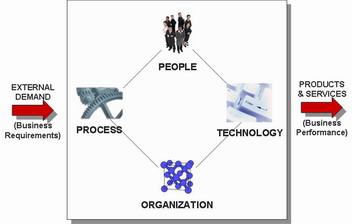1. M. Stoica, N. Chawat, N. Shin (2004), "An Investigation of the Methodologies of Business Process Reengineering"
2. R. Maull, S. Childe (1993), "Business Process Regineering : An Example from the Banking Sector"
3. L. K. Gaafar, Business Process Regineering
=================================================================================
The Five Phase approach, which is one of the BPR Methodologies, is introduced in this lecture.

Phrase 1 : Triggering & Executive Visioning
In this phrase, the business direction, vision and objectives are first defined. Triggers, which can be classified as internal and external, are then discovered. For internal, The inefficiencies in existing business processes will be identified and examined. Some example are complicated steps, late in completion and much lead time. For external, environmental change and pressure from competitors are some of the example. Organizational objectives will be prioritized according to the re-engineering opportunities and customer impact.
Phrase 2 : Mobilization
After the essential processes identification and prioritization, human resource should be assigned appropriately. (e.g. selecting the leader and forming the team with tasks allocation)
Phrase 3 : Process redesign
5 Steps are involved in this stage, namely Scoping, Modelling, Analysis, Redesign and Integration. The best redesign "To-be" options will be chosen among its alternatives.
Phrase 4 : Implementation
After the selection of the redesign process, IT infrastructure, organization and skills will be adjust so as to fit the process.
Phrase 5 : Monitoring and Maintaining
Finally, continuous monitoring of the new process is incurred. Modification is needed when necessary.
Reflection: Which phrase is the most important?
The five phrase approach gives us a clear and systematic guidelines to organization transformation and problem solving. Obviously, all phrase is critical towards the success of the BPR. I indeed believe that the first phrase (Visioning) is the most essential element. "If you fail to plan, you plan to fail." Planning and preparation are always the most vital factors for any business activities to be successful. Before we start, we should have a clear understanding regarding the objective and the trigger of the project and stick to that throughout the whole BPR. A comprehensive visioning can assist in the smooth operation of BPR and avoid wasting any resources.
Summary of BPR methodologies from other contemporary literature (refer to ref. 1)
There are many other BPR methodologies definition suggested by other researchers, which will be summarized as below:
Notes:
Methodology #1 : Unknown (1997)
Methodology #2 : Harrison and Pratt (1993)
Methodology #3 : Furey (1993)
Methodology #4 : Mayer & Dewitte (1998)
Methodology #5 : Manganelli & Klein (1994)
All methodology has its own merits and can assist in the the BPR project design.
Case study: Eastman Kodak Company (refer to ref. 3)


Kodak is an American multinational company which offers imaging and photographic equipment, materials and services. Before the implementation of BPR, Kodak achieved considerable improvement in cost, cycle time and quality. However, the improvement was not dramatic. BPR project was therefore planned to be executed with the use of methodology as below:
Phrase 1 : Project initiation
- Project planning
- Definition of all project administration rules and procedures
Phrase 2 : Process understanding
- Set the project team
- Design comprehensive process model for the organization
- Assign process managers who are responsible for the redesigned process after execution
Phrase 3 : New process design
- Redesign of selected Business Processes
- Consider the potentials of Information Technology
- Plan of a Pilot Implementation of the redesigned processes
Phrase 4 : Business Transition
- Implementation of the newly designed processes within the organization
- Adaptation of the organization's infrastructure to the requirements of new system
Phrase 5 : Change Management
- Perform parallel to step 1-4
- Handling of barriers by the project team
More example can be found in the reference 3.
To conclude, as we all know the importance of BPR in business improvement. However
simply planning and execution of the strategy is insufficient to develop a comprehensive and effective BPR project. Therefore, it is highly recommended that the companies should follow the systematic BPR methodology in establishing the BPR project. It is believed that the failure rate and risk of project implementation will definitely decrease by doing so.






